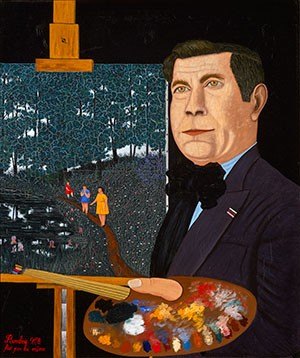Born 1883, Venarey-les-Laumes, France
Died 1970, Paris, France
Although not overly given to art theory, Camille Bombois held fast to one principle: that the best art came from a life closely observed. Born in the Côte d’Or region of eastern France, Bombois grew into a strapping, muscular individual, who worked as a farmer, circus strongman, Paris subway builder, and newspaper machine operator. He painted on the side and sometimes drew artistic inspiration from his other occupations. Bombois began to dedicate more time to painting after distinguished military service in World War I. He attracted immediate attention from journalists, collectors, and dealers who saw his works displayed on Montmartre’s sidewalks in the early 1920s. By 1938, when he was included in MoMA’s Masters of Popular Painting exhibition, Bombois stood out among self-taught artists for already having an established career on both sides of the Atlantic.
Bombois gained a reputation as a painter of the common man, concentrating primarily on naturalistic views of daily life in France’s villages and cities as well as landscapes of the French countryside, especially its lakes and rivers. He set volumetric forms and rounded human figures, generally either working or enjoying leisure activities, within luminous scenes of exquisite detail. Critics have likened the crisp edges and bold colors of his compositions to Henri Rousseau’s, but Bombois resisted the fantastical and was committed to picturing the local rather than the exotic.
Nevertheless, a certain whimsy permeates his imagery, especially in his abiding fascination with the circus. Before Entering the Ring, a painting that Alfred H. Barr Jr. bought for MoMA after the landmark 1938 exhibition, reflects the artist’s firsthand knowledge as a former circus performer—lingering on preparatory moments behind the dazzling feats of strength and skill that captivated late nineteenth-century artists like Edgar Degas, Georges Seurat, and Henri de Toulouse-Lautrec. Bright, saturated colors enhance the tangible props and animals as well as attendants and performers who await their entrances with nonchalance—or so their masks suggest. For Bombois, the circus was an appealing subject for making existential statements.
Kara Fiedorek
Jakovsky, Anatole. Naïve Painting. Trans. Ernest Torlesse. Oxford: Phaidon, 1979.
Uhde, Wilhelm. Five Primitive Masters. Trans. Ralph Thompson. New York: Quadrangle Press, 1949.
